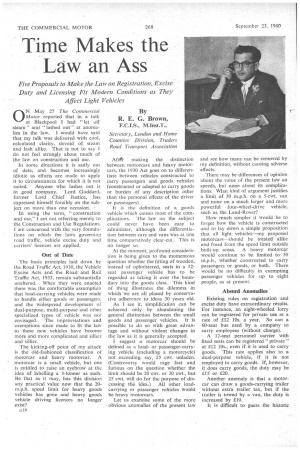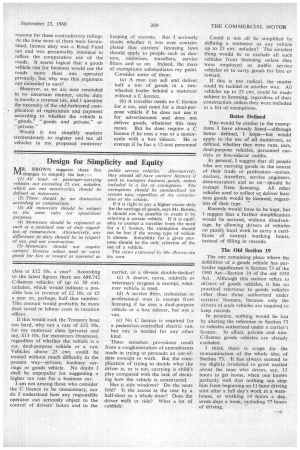Time Makes the Law an Ass
Page 136

Page 137

If you've noticed an error in this article please click here to report it so we can fix it.
Five Proposals to Make the Law on Registration, Excise Duty and Licensing Fit Modern Conditions as They Affect Light Vehicles
By R. E. G. Brown,
F.C.I.S., M.Inst.T., Secretary, London and Home Counties Division, Traders Road Transport Association ON May 27 The Commercial Motor reported that in a talk at Blackpool I had "let off steam" and "lashed out" at anomalies in the law. I would have said that my talk was delivered with cool, calculated clarity, devoid of steam and lash alike. That is not to say I do not feel strongly about much of the law on construction and use.
In some directions it is sadly out of date, and becomes increasingly idiotic as efforts are made to apply it to circumstances for which it is not suited. Anyone who lashes out is in good company, Lord Goddard. former Lord Chief Justice, has expressed himself forcibly on the subject on more than one occasion. • In using the term, "construction and use," I am not referring merely to the Construction and Use Regulations. I am concerned with the very foundations on which the laws governing road traffic, vehicle excise duty and carriers' licences are applied.
Out of Date
The basic principles laid down by the Road Traffic Act, 1930, the Vehicle Excise Acts and the Road and Rail Traffic Act, 1933, remain substantially unaltered. When they were enacted there was the comfortable assumption that load-carrying vehicles were made to handle either goods or passengers, and the widespread development of dual-purpose, multi-purpose and other specialized types of vehicle was not envisaged. The improvisations and exemptions since made to fit the law to these new vehicles have become more and more complicated and sillier and sillier.
The kicking-off point of my attack is the old-fashioned classification of motorcar and heavy motorcar. A motorcar is a small vehicle, but one is entitled to raise an eyebrow at the idea of labelling a 3-tonner as such. Be that as it may, has this division any practical value now that the 20m.p.h. speed limit for heavy goods vehicles has gone and heavy goods vehicle driving licences no longer exist?
(318
After making the distinction between motorcars and heavy motorcars, the 1930 Act goes on to differentiate between vehicles constructed to carry passengers and goods vehicles (constructed or adapted to carry goods or burden of any description other than the personal effects of the driver or passengers).
It is the definition of a goods vehicle which causes most of the complications. The law on the subject could never have been easy to administer, although the differentiation between cars and vans was at one time comparatively clear-cut. This is no longer so.
At the moment, profound consideration is being given to the momentous question whether the fitting of wooden, instead of upholstered, seats in a 12seat passenger vehicle has to be regarded as taking it over the boundary into the goods class. This kind of thing illustrates the dilemma in which we are all placed by conservative adherence to ideas 30 years old.
As I see it, simplification can be achieved only by abandoning the general distinction between the small goods and passenger vehicles. It is possible to do so with great advantage and without violent changes in the law as it is generally accepted.
I suggest a motorcar should be defined as a loador passenger-carrying vehicle (excluding a motorcycle) not exceeding, say, 25 cwt. unladen. (Controversy would rage fast and furious on the question whether the limit should be 20 cwt. or 30 cwt., but 25 cwt. will do for the purpose of discussing the idea.) All other loadcarrying Or passenger vehicles would be heavy motorcars.
Let us examine some of the more obvious anomalies of the present law and see how many can be removed by my definition, without causing adverse effects.
There may be differences of opinion about the value of the present law on speeds, but none about its complications. What kind of argument justifies a limit of 30 m.p.h. on a 5-cwt. van and none on a much larger and more powerful four-wheel-drive vehicle, such as the Land-Rover?
How much simpler it would be to forget how the vehicle is constructed and to lay down a simple proposition that all light vehicles—my proposed motorcars—should be treated alike and freed from the speed limit outside built-up areas. A heavy motorcar would continue to be limited to 30 m.p.h., whether constructed to carry passengers or goods, or both. There would be no difficulty in exempting . passenger vehicles for up to eight people, as at present.
Absurd Anomalies
Existing rules on registration and excise duty have extraordinary results. For instance, an eight-wheeled lorry can be registered for private use at a rate of £12 10s. a year. So can a 60-seat bus used by a company to carry employees (without charge).
A 12-seat personnel carrier with fixed seats can be registered " private " at £12 I0s., even if it is used to carry goods. This rate applies also to a dual-purpose vehicle, if it is not employed to carry goods. If, however, it does carry goods, the duty may be £15 or £20.
Another anomaly is that a motorcar can draw a goods-carrying trailer without extra trailer tax, but if the trailer is towed by a van, the duty is increased by £10.
It is difficult to guess the historic reasons for these contradictory rulings. At the time most of them were formulated, licence duty was a Road Fund tax and was presumably intended to reflect the comparative use of the roads. It seems logical that a goods vehicle run for business would use the roads more than one operated privately, but why was this argument not extended to cars?
However, as we are now reminded in no uncertain manner, excise duty is rnerely.a revenue tax, and I question the necessity of the old-fashioned complication of registration and payment according to whether the vehicle is "goods," "goods and private," or "private."
Would it not simplify matters tremendously to register and tax all vehicles in my proposed motorcar class at £12 10s. a year? According to the latest figures there are 688,742 C-licence vehicles of up to 30 cwt. unladen, which would indicate a possible loss in revenue of £2 10s. or £5 a year on, perhaps, half that number. This amount would probably be more than saved in labour costs in taxation offices.
If this would rock the Treasury boat too hard, why not a rate of £12 10s. for my motorcar class (private) and say, £13 10s. for motorcars (business), regardless of whether the vehicle is a car, dual-purpose vehicle or a van. Vehicles above 25 cwt. could be treated without much difficulty in the present way—private, hackney carriage or goods vehicle. No doubt I shall be unpopular for suggesting a higher tax rate for a business car.
I am not among those who consider the C licence to be unnecessary, nor . do I understand how any responsible operator can seriously object to the control of drivers' hours and to the keeping of records. But I seriously doubt whether it was ever contemplated that carriers' licensing laws should apply to people such as doctors, midwives, travellers, service fitters and so on. Indeed, the mass of exemptions substantiates my point.
Consider some of them: (a) A man can sell and deliver half a ton of goods in a twowheeled trailer behind a motorcar without a C licence.
(b) A traveller needs no C licence for a car, and none for a dual-purpose vehicle if he does not use it for advertisement and does not deliver goods, whatever this may mean. But he does require a C licence if he uses a van or a motorcycle with a box sidecar. He is exempt if he has a 12-seat personnel carrier, or a 60-seat double-decker!
(c) A doctor, nurse, midwife or veterinary surgeon is exempt, whatever vehicle is used.
(d) A service fitter, technician or professional man is exempt from licensing if he uses a dual-purpose vehicle or a box sidecar, but not a van.
(e) No C licence is required for a pedestrian-controlled electric van, but one is needed for any other kind.
These senseless provisions result from a conglomeration of amendments made in trying to persuade an out-ofdate concept to work. But the complication of trying to decide what the driver is, or is not, carrying is child's play compared with the task of deciding how the vehicle is constructed.
Has it side windows? Do the seats fold? Is the access at the rear by a half-door or a whole door? Does the driver walk or ride? What a lot of rubbish! Could it not all be simplified by defining a motorcar as any vehicle up to 25 cwt. unladen? The simplest thing would be to exclude all such vehicles from licensing unless they were employed as public service vehicles or to carry goods for hire or reward.
If this is too radical, the matter could be tackled in another way. All vehicles up to 25 cwt. could be made subject to licensing, regardless of their construction, unless they were included in a list of exemptions.
Better Defined
This would be similar to the exemptions I have already listed—although better defined, 1 hope--but would apply to the use of all motorcars, as defined, whether they were vans, cars, dual-purpose vehicles, personnel carriers or box-sidecar outfits.
In general, I suggest that all people who are carrying goods in the course of their trade or profession—nurses, doctors, travellers, service engineers, demonstrators and so on—s,hould be exempt from licensing. All other vehicles used to collect or deliver business goods would be licensed, regardless of their type.
Records would have to be kept, but I suggest that a further simplification would be secured, without disadvantage, by allowing drivers of vehicles on purely local work to carry a certificate of normal working hours, instead of filling in records.
The Old Section 19
The one remaining place where the definition of a goods vehicle has particular significance is Section 73 of the 1960 Act—Section 19 of the old 1930 Act. Although this section refers to drivers of goods vehicles, it has no practical relevance to goods vehicles other than those authorized under carriers' licences, because only the drivers of such vehicles are required to keep records.
In practice, nothing would be lost by altering the reference in Section 73 to vehicles authorized under a carrier's licence. In effect, private and nonC-licence goods vehicles are already excluded.
I think there is scope for the re-examination of the whole idea of Section 73. It has always seemed to me slightly irrational to grow excited • about the man who drives, say, 13 hours to get home, when one knows perfectly well that nothing can stop him from beginning an 11-hour driving stint after a full day's work in a warehouse, or working 14 hours a day, seven days a week, including 77 hours of driving.




































































































































































































































































































































































